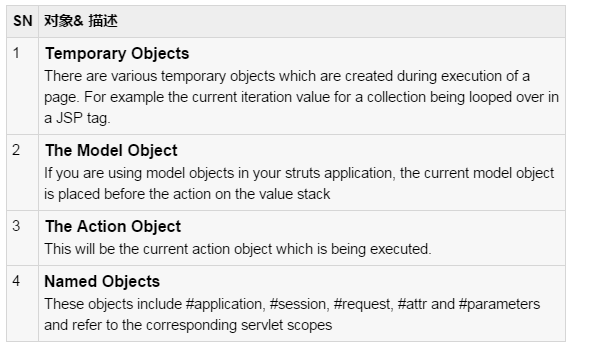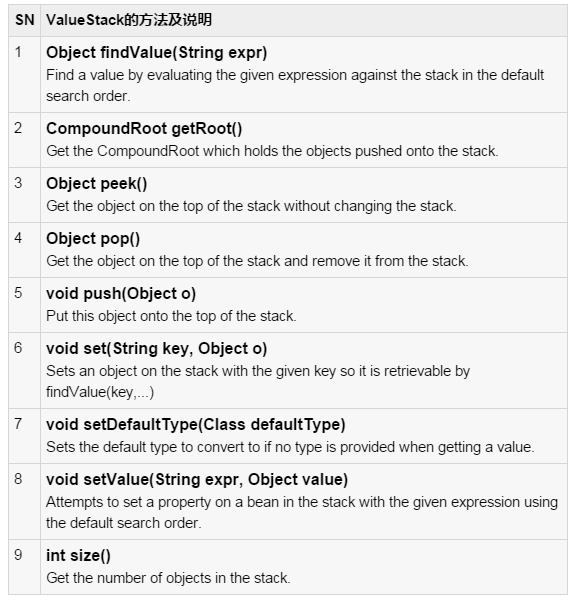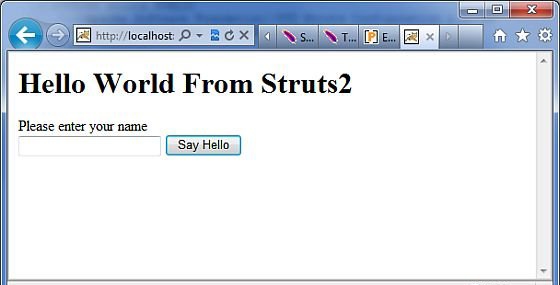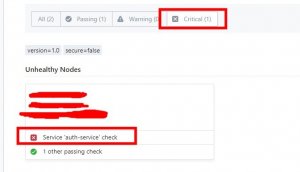值栈:
值栈是一个集合中的几个对象保持下列对象提供的顺序:

值栈可以通过JSP,Velocity或者Freemarker的标签。有各种不同的标签在单独的章节中,我们将学习,用于获取和设置Struts 2.0 的值栈。 ValueStack的对象里面可以得到动作如下:
ActionContext.getContext().getValueStack()
一旦拥有了值对象,就可以用下面的方法来操纵该对象:

OGNL:
对象图形导航语言(OGNL)是一个功能强大的表达式语言是用来参考值栈上的数据和操纵。 OGNL也有助于在数据传输和类型转换。
OGNL和JSP表达式语言很相似。 OGNL 基础的理念是在 root或默认的对象范围内。默认或根对象的属性,可以参考使用的标记符号(井号)。
如前所述,OGNL是基于上下文和Struts的构建ActionContext 使用OGNL映射。ActionContext中映射包括以下:
application - 应用范围的变量
session - 会话范围的变量
root / value stack - 所有操作变量都保存在这里
request - 请求范围的变量
parameters - 请求参数
atributes - 存储的属性页面,请求,会话和应用范围
重要的是要明白,操作对象是始终可用值栈中的。所以,因此,如果动作对象的属性x和y有随时供使用。
在ActionContext中的对象被称为使用井号的符号,但是,值栈中的对象可以被直接引用,例如,如果员工是一个动作类的属性,那么就可以得到如下参考:
|
1
|
<s:property value="name"/> |
来代替
|
1
|
<s:property value="#name"/> |
如果会话中有一个属性叫做“login”,可以找回如下:
|
1
|
<s:property value="#session.login"/> |
OGNL还支持处理的集合 - 即映射,List和Set。例如,以显示颜色的下拉列表,可以这样做:
|
1
|
<s:select name="color" list="{'red','yellow','green'}" /> |
本OGNL表达式是巧妙地的解释 "red","yellow","green"为颜色,并此基础上建立一个列表。
OGNL表达式将被广泛使用时,在接下来的章节中,我们将研究不同的标签。因此,让我们来看看它使用的一些例子在Form标签/标签/数据标签控制和Ajax标签。
ValueStack/OGNL 例子: 创建动作:
让我们考虑以下动作类,当我们访问值栈,然后设置几个键,我们将在视图,即访问使用OGNL,JSP页面。
|
1
2
3
4
5
6
7
8
9
10
11
12
13
14
15
16
17
18
19
20
21
22
23
24
25
26
27
28
29
30
31
|
package com.yiibai.struts2;import java.util.*; import com.opensymphony.xwork2.util.ValueStack;import com.opensymphony.xwork2.ActionContext;import com.opensymphony.xwork2.ActionSupport;public class HelloWorldAction extends ActionSupport{ private String name; public String execute() throws Exception { ValueStack stack = ActionContext.getContext().getValueStack(); Map<String, Object> context = new HashMap<String, Object>(); context.put("key1", new String("This is key1")); context.put("key2", new String("This is key2")); stack.push(context); System.out.println("Size of the valueStack: " + stack.size()); return "success"; } public String getName() { return name; } public void setName(String name) { this.name = name; }} |
其实,Struts 2的值栈的顶部增加了动作时执行。所以,通常的方法是把东西值栈添加 getter/setter方法以使这些值在Action类,然后使用<s:property>标签来访问值。以下是展示如何在struts ActionContext 中 ValueStack 工作。
创建视图
让我们创建以下JSP文件 helloWorld.jsp 的要 WebContent 文件夹。这个视图将被显示动作返回“success”:
|
1
2
3
4
5
6
7
8
9
10
11
12
|
<%@ page contentType="text/html; charset=UTF-8" %><%@ taglib prefix="s" uri="/struts-tags" %><html><head><title>Hello World</title></head><body> Entered value : <s:property value="name"/><br/> Value of key 1 : <s:property value="key1" /><br/> Value of key 2 : <s:property value="key2" /> <br/></body></html> |
我们还需要创建的index.jsp在WebContent文件夹,其内容如下:
|
1
2
3
4
5
6
7
8
9
10
11
12
13
14
15
16
17
18
|
<%@ page language="java" contentType="text/html; charset=ISO-8859-1" pageEncoding="ISO-8859-1"%><%@ taglib prefix="s" uri="/struts-tags"%> <!DOCTYPE html PUBLIC "-//W3C//DTD HTML 4.01 Transitional//EN""http://www.w3.org/TR/html4/loose.dtd"><html><head><title>Hello World</title></head><body> <h1>Hello World From Struts2</h1> <form action="hello"> <label for="name">Please enter your name</label><br/> <input type="text" name="name"/> <input type="submit" value="Say Hello"/> </form></body></html> |
配置文件
以下是struts.xml文件的内容:
|
1
2
3
4
5
6
7
8
9
10
11
12
13
14
15
16
17
|
<?xml version="1.0" encoding="UTF-8"?><!DOCTYPE struts PUBLIC "-//Apache Software Foundation//DTD Struts Configuration 2.0//EN" "http://struts.apache.org/dtds/struts-2.0.dtd"><struts> <constant name="struts.devMode" value="true" /> <package name="helloworld" extends="struts-default"> <action name="hello" class="com.yiibai.struts2.HelloWorldAction" method="execute"> <result name="success">/HelloWorld.jsp</result> </action> </package></struts> |
以下是web.xml文件中的内容:
|
1
2
3
4
5
6
7
8
9
10
11
12
13
14
15
16
17
18
19
20
21
22
23
24
|
<?xml version="1.0" encoding="UTF-8"?><web-app xmlns:xsi="http://www.w3.org/2001/XMLSchema-instance" xmlns="http://java.sun.com/xml/ns/javaee" xmlns:web="http://java.sun.com/xml/ns/javaee/web-app_2_5.xsd" xsi:schemaLocation="http://java.sun.com/xml/ns/javaee http://java.sun.com/xml/ns/javaee/web-app_3_0.xsd" id="WebApp_ID" version="3.0"> <display-name>Struts 2</display-name> <welcome-file-list> <welcome-file>index.jsp</welcome-file> </welcome-file-list> <filter> <filter-name>struts2</filter-name> <filter-class> org.apache.struts2.dispatcher.FilterDispatcher </filter-class> </filter> <filter-mapping> <filter-name>struts2</filter-name> <url-pattern>/*</url-pattern> </filter-mapping></web-app> |
右键点击项目名称,并单击Export > WAR File创建一个WAR文件。然后将此WAR 部署在Tomcat 的 webapps目录下。最后,启动Tomcat服务器和尝试访问URL http://localhost:8080/HelloWorldStruts2/index.jsp。如以下画面:

现在在给定的文本框中输入任何单词,然后点击"Say Hello"按钮执行已定义的动作。现在,如果检查生成的日志,会发现下面的文本底部:
|
1
|
Size of the valueStack: 3 |
这将显示以下画面,这将显示任何的值,将进入值为key1和key2,我们已经把它们放入 ValueStack。














